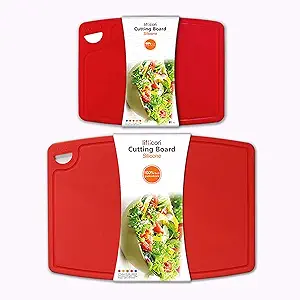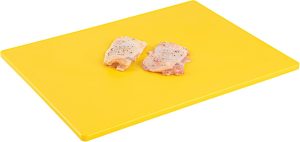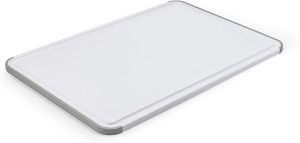Last Updated on September 4, 2025 by Susanna Zuyeva
Color Cutting Board Chart: Your Complete Guide to Kitchen Food Safety
Food safety starts with smart choices. A color cutting board chart helps you avoid dangerous cross-contamination. This system keeps harmful bacteria away from your food.
Many home cooks use just one cutting board. This habit puts families at risk. Raw chicken juices can spread to vegetables. Seafood bacteria can contaminate bread. These mistakes cause food poisoning.
Professional kitchens follow strict color codes. Health inspectors require this system. Now you can use the same protection at home.
Understanding the Color Cutting Board System
The color cutting board system assigns specific colors to different food types. Each color handles one category of ingredients. This method prevents bacteria from spreading between foods.
Food service professionals created this system decades ago. The HACCP (Hazard Analysis Critical Control Points) guidelines support color coding. The FDA recommends separate cutting surfaces for different foods.
Why Color Coding Works
Your brain processes colors faster than text labels. Red means raw meat. Blue means seafood. These associations become automatic with practice.
Color coding also helps during busy cooking times. You grab the right board without thinking. This speed prevents mistakes when you’re rushing.
The Complete Color Cutting Board Chart
Red Cutting Boards – Raw Red Meat
Red boards handle all raw red meats. This includes beef, pork, lamb, and venison. The red color matches the meat’s appearance.
Raw red meat carries dangerous bacteria like E. coli and Salmonella. These pathogens cause severe food poisoning. The red board contains these risks.
Always use red boards for:
- Raw steaks and roasts
- Ground beef and pork
- Raw bacon and sausages
- Lamb chops and legs
- Venison and game meats
Blue Cutting Boards – Raw Seafood
Blue boards are for all raw fish and shellfish. The blue color represents water where seafood lives. This association helps you remember the rule.
Raw seafood carries unique bacteria and parasites. Vibrio and norovirus are common threats. These pathogens don’t affect other meat types the same way.
Use blue boards for:
- Fresh fish fillets
- Whole fish preparation
- Raw shrimp and crab
- Oysters and clams
- Sushi-grade fish
Yellow Cutting Boards – Raw Poultry
Yellow boards handle all raw poultry products. This includes chicken, turkey, duck, and other birds. The yellow color stands out as a warning.
Poultry carries Campylobacter and Salmonella bacteria. These germs cause millions of illnesses yearly. Raw chicken is especially dangerous.
Yellow boards are for:
- Whole chickens and parts
- Ground turkey and chicken
- Duck and game birds
- Raw chicken wings and thighs
- Turkey breasts and legs
Green Cutting Boards – Fresh Produce
Green boards match the color of vegetables and herbs. This natural association makes the system easy to remember. Fresh produce gets the green treatment.
While produce seems safe, it can carry harmful bacteria too. E. coli outbreaks often trace back to lettuce and spinach. Washing helps, but separation is better.
Green boards handle:
- Leafy greens and lettuce
- Fresh herbs and vegetables
- Raw fruits for cooking
- Salad ingredients
- Vegetable prep work
White Cutting Boards – Dairy and Bread
White boards represent purity and cleanliness. These boards handle ready-to-eat foods that won’t be cooked further. The white surface shows dirt easily.
Dairy products and bread don’t need cooking. Any bacteria on these foods goes straight into your body. Clean white boards provide the safest surface.
White boards work for:
- Cheese cutting and slicing
- Bread and pastry prep
- Butter and dairy work
- Ready-to-eat foods
- Clean ingredient prep
Brown Cutting Boards – Cooked Meats
Brown boards handle foods that are already cooked. The brown color represents the cooked appearance of meats. These foods are safer but still need protection.
Cooked meats can pick up bacteria from dirty surfaces. Cross-contamination ruins safe food. Brown boards keep cooked items separate from raw ones.
Brown boards are perfect for:
- Slicing cooked roasts
- Carving holiday turkeys
- Cutting deli meats
- Prepared meat dishes
- Cooked sausages and hot dogs
The Science of Cross-Contamination Prevention
Cross-contamination happens when bacteria move from one food to another. Raw meats carry the most dangerous germs. These bacteria can make you very sick.
Common Bacterial Threats
Salmonella lives in poultry, eggs, and some vegetables. This bacteria causes fever, cramps, and diarrhea. Symptoms last up to a week.
E. coli hides in ground beef and fresh produce. Some strains cause kidney failure. Children and elderly people face the highest risks.
Campylobacter thrives in chicken and unpasteurized milk. This germ causes bloody diarrhea and stomach pain. Recovery takes several days.
Listeria grows in deli meats and soft cheeses. Pregnant women can lose their babies to this bacteria. Healthy adults usually recover quickly.
How Color Coding Stops Bacteria
Each colored board creates a barrier against bacterial spread. Raw chicken bacteria stay on the yellow board. They can’t reach the vegetables on the green board.
Washing your hands between boards adds extra protection. Soap and hot water kill most bacteria. This habit works with color coding to keep food safe.
Choosing the Right Cutting Board Materials
Plastic Cutting Boards
Plastic boards work best for the color coding system. They come in bright colors that are easy to see. Plastic boards also cost less than other materials.
High-density polyethylene (HDPE) makes the best plastic boards. This material resists bacteria and knife cuts. The smooth surface cleans easily.
Plastic boards go in the dishwasher safely. Hot water and soap kill remaining bacteria. Air drying prevents new germ growth.
Wood Cutting Boards
Wood boards have natural antibacterial properties. The wood fibers trap and kill some bacteria. However, wood boards are harder to clean completely.
Hardwoods like maple and walnut work best. These woods resist knife marks and splitting. Soft woods like pine damage easily and harbor bacteria.
Wood boards need special care. Never put them in the dishwasher. The heat and moisture cause cracking and warping.
Bamboo Cutting Boards
Bamboo grows faster than traditional hardwoods. This makes bamboo boards more eco-friendly. The material is naturally antibacterial too.
Bamboo boards feel similar to wood but cost less. They resist knife marks better than soft woods. The light color shows stains and wear clearly.
Like wood, bamboo boards need hand washing only. Oil treatments keep the surface in good condition. Replace bamboo boards when they show deep cuts.
Glass and Stone Boards
Glass and stone boards are very easy to clean. Bacteria can’t hide in the smooth surface. These materials go in the dishwasher safely.
However, glass and stone dull knives quickly. The hard surface chips knife edges. Professional chefs avoid these materials for this reason.
Glass boards can shatter if dropped. Stone boards are very heavy and expensive. Most home cooks find plastic or wood more practical.
Size and Thickness Guidelines
Small Boards (8×10 inches)
Small boards work for simple tasks like slicing cheese or cutting herbs. They fit in small kitchens and store easily. However, small boards limit your cutting space.
Use small boards for:
- Quick garnish prep
- Single-serving portions
- Apartment kitchens
- Travel and camping
Medium Boards (12×16 inches)
Medium boards handle most home cooking tasks. They provide enough space for vegetables and small roasts. This size balances workspace with storage needs.
Medium boards are ideal for:
- Daily meal preparation
- Family-sized portions
- Standard home kitchens
- Most cooking projects
Large Boards (18×24 inches)
Large boards work for big cooking projects. Holiday meal prep and batch cooking need this extra space. Professional kitchens prefer large boards.
Choose large boards for:
- Holiday cooking
- Meal prep sessions
- Large families
- Serious home cooks
Thickness Matters
Thick boards (1 inch or more) last longer and resist warping. They also provide a more stable cutting surface. However, thick boards take up more storage space.
Thin boards (1/2 inch) store easily and cost less. They work fine for light cutting tasks. Heavy chopping can damage thin boards quickly.
Proper Cleaning and Maintenance
Daily Cleaning Protocol
Clean each board immediately after use. Don’t let bacteria multiply while you finish cooking. Quick cleaning prevents staining and odors too.
Step 1: Scrape off food debris with a bench scraper or knife edge.
Step 2: Rinse with hot water to remove loose particles.
Step 3: Scrub with dish soap and a stiff brush. Pay attention to knife cuts and grooves.
Step 4: Rinse thoroughly with hot water.
Step 5: Air dry completely before storing.
Deep Cleaning Methods
Deep clean your boards weekly or after handling very messy foods. This process removes stubborn stains and kills hidden bacteria.
Bleach Solution: Mix 1 tablespoon bleach with 1 gallon water. Soak plastic boards for 2 minutes. Rinse thoroughly and air dry.
Vinegar Treatment: White vinegar kills many bacteria naturally. Spray full-strength vinegar on the board surface. Let sit for 5 minutes before rinsing.
Baking Soda Paste: Mix baking soda with water to form a thick paste. Scrub stained areas with this mixture. The abrasive action removes tough stains.
Storage Best Practices
Store cutting boards in a clean, dry place. Moisture encourages bacterial growth. Good air circulation prevents mold and mildew.
Vertical Storage: Stand boards on edge in a rack or slot system. This method saves space and allows air circulation around each board.
Horizontal Stack: If you must stack boards, place paper towels between them. This prevents moisture trapping and bacterial growth.
Wall Mounting: Mount boards on wall hooks or magnetic strips. This keeps them visible and easily accessible during cooking.
When to Replace Cutting Boards
Warning Signs
Replace cutting boards when they show these warning signs:
Deep Knife Cuts: Grooves deeper than 1/8 inch harbor bacteria. These cuts are impossible to clean completely.
Permanent Stains: Dark stains that won’t clean may indicate bacterial growth. Don’t risk your family’s health with stained boards.
Warping or Cracking: Damaged boards create uneven surfaces. Food particles get trapped in cracks and splits.
Strong Odors: Persistent smells mean bacteria are growing inside the board material. Cleaning can’t remove these deep infections.
Replacement Schedule
Plastic Boards: Replace every 1-2 years with heavy use. Light use boards may last 3-4 years.
Wood Boards: Quality hardwood boards can last 5-10 years with proper care. Softwood boards need replacement sooner.
Bamboo Boards: Expect 2-4 years of service from bamboo boards. Quality varies widely between manufacturers.
Setting Up Your Color-Coded System
Home Kitchen Implementation
Start with the most important colors for your cooking style. Most families need red, yellow, and green boards at minimum. Add other colors as your system develops.
Budget Approach: Buy one new colored board each month. This spreads the cost over time. Start with the colors you need most often.
Complete Set: Buy all six colors at once if your budget allows. Having the complete system from day one builds better habits.
Commercial Kitchen Standards
Professional kitchens must follow health department rules. The color coding system is often required by law. Staff training is essential for success.
Health Inspector Requirements: Check local regulations for specific color requirements. Some areas have different standard colors.
Staff Training: Every employee must know the color system. Regular reminders and testing keep standards high.
Supplier Coordination: Work with food suppliers who understand your color system. They can help maintain consistency.
Training Family Members
Making It Easy to Remember
Use memory tricks to help family members learn the system quickly. Visual associations work better than rules.
Color Associations:
- Red = Raw red meat (both are red)
- Blue = Water/seafood (fish live in blue water)
- Yellow = Caution/chicken (yellow means be careful)
- Green = Go/vegetables (green vegetables are healthy)
- White = Pure/dairy (milk is white and pure)
- Brown = Cooked/finished (cooked meat looks brown)
Creating Good Habits
Post Reminders: Put a chart on your refrigerator or pantry door. Visual reminders help during the learning phase.
Practice Together: Cook meals together using the color system. Hands-on practice builds muscle memory.
Explain the Why: Help family members understand food safety reasons. People follow rules better when they understand the purpose.
Common Mistakes to Avoid
Using the Wrong Board: Double-check colors before you start cutting. This prevents dangerous mistakes.
Skipping the Cleaning: Each board needs cleaning after every use. Lazy cleaning defeats the safety purpose.
Mixing Colors: Never use one board for multiple food types during the same meal prep session.
Advanced Tips for Success
Meal Planning Integration
Plan your meals around the color coding system. Group similar foods together to reduce board changes. This makes cooking more efficient.
Prep Order: Start with foods that need the cleanest boards (white and green). Save raw meat prep for last.
Batch Processing: Cut all vegetables at once on the green board. Process all raw meats together on their designated colors.
Professional Techniques
Board Positioning: Keep boards in consistent locations. Muscle memory helps you grab the right color automatically.
Knife Pairing: Some chefs assign specific knives to specific board colors. This prevents cross-contamination from knife blades.
Timing Strategy: Use separate prep stations for raw and cooked foods. This physical separation adds another safety layer.
Troubleshooting Common Problems
Limited Counter Space
Small kitchens struggle with multiple cutting boards. Creative solutions help you maintain food safety in tight spaces.
Magnetic Boards: Some cutting boards have magnetic backs. They stick to refrigerator sides when not in use.
Nesting Sets: Look for boards that nest inside each other. This saves storage space while maintaining the color system.
Folding Boards: Some manufacturers make boards that fold in half. These take up less counter space during use.
Budget Constraints
Good cutting boards cost money, but food poisoning costs more. Budget-friendly options still provide safety benefits.
Flexible Mats: Thin, flexible cutting mats cost less than traditional boards. They work well for light cutting tasks.
Gradual Building: Buy one quality board at a time instead of a cheap complete set. Quality boards last longer and work better.
Sales and Discounts: Watch for kitchen store sales and bulk discounts. Restaurant supply stores often have better prices.
Frequently Asked Questions
What happens if I use the wrong color cutting board?
Using the wrong color won’t hurt you directly, but it defeats the safety purpose. Clean the board thoroughly before switching food types. Consider the contamination risk and act accordingly.
Can I use the same cutting board for different vegetables?
Yes, the green board can handle all types of fresh produce. Vegetables and fruits generally carry similar contamination risks. Just clean the board between very different foods like onions and strawberries.
How do I clean cutting boards that smell bad?
Strong odors usually mean deep bacterial growth. Try soaking in a bleach solution (plastic boards only) or replacing the board entirely. Prevention through proper cleaning works better than odor removal.
Are expensive cutting boards worth the money?
Quality boards last longer and resist bacteria better. However, proper cleaning and replacement matter more than price. A well-maintained cheap board beats a neglected expensive one.
Can I put wooden cutting boards in the dishwasher?
Never put wood or bamboo boards in the dishwasher. The heat and moisture cause cracking, warping, and splitting. Hand wash these materials with soap and hot water.
What’s the best way to store multiple cutting boards?
Vertical storage works best for air circulation and space efficiency. Wall-mounted racks, counter slots, or cabinet organizers all work well. Avoid stacking wet boards.
How often should I replace my cutting boards?
Replace boards when they show deep cuts, permanent stains, cracks, or persistent odors. Most plastic boards need replacement every 1-2 years. Quality wood boards can last 5-10 years with proper care.
Do I really need all six colors?
Start with the colors you use most often. Most home cooks need red (raw meat), yellow (poultry), and green (vegetables) at minimum. Add other colors as your needs and budget allow.
What size cutting board should I buy?
Medium boards (12×16 inches) work for most home cooking tasks. Buy larger boards if you cook for big families or do lots of meal prep. Small boards work for apartments and simple tasks.
Can I use glass or stone cutting boards?
Glass and stone boards are very sanitary but damage knife edges quickly. Most professional chefs avoid these materials. Plastic, wood, or bamboo provide better knife protection while still maintaining food safety.







